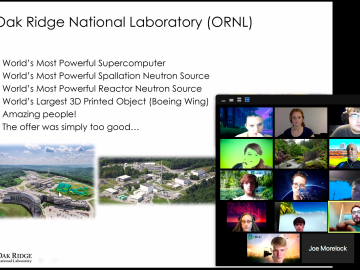Filter News
Area of Research
- (-) National Security (21)
- Biology and Environment (36)
- Clean Energy (56)
- Computer Science (1)
- Electricity and Smart Grid (1)
- Fuel Cycle Science and Technology (1)
- Fusion and Fission (18)
- Fusion Energy (4)
- Isotopes (13)
- Materials (50)
- Materials for Computing (1)
- Neutron Science (24)
- Nuclear Science and Technology (12)
- Quantum information Science (2)
- Supercomputing (60)
News Topics
- Artificial Intelligence (3)
- Big Data (2)
- Computer Science (2)
- Cybersecurity (5)
- Decarbonization (1)
- Environment (1)
- Grid (1)
- High-Performance Computing (2)
- Machine Learning (5)
- Materials (1)
- Materials Science (2)
- Nanotechnology (1)
- National Security (11)
- Neutron Science (1)
- Nuclear Energy (1)
- Security (2)
Media Contacts

Using disinformation to create political instability and battlefield confusion dates back millennia. However, today’s disinformation actors use social media to amplify disinformation that users knowingly or, more often, unknowingly perpetuate. Such disinformation spreads quickly, threatening public health and safety. Indeed, the COVID-19 pandemic and recent global elections have given the world a front-row seat to this form of modern warfare.

Four nuclear nonproliferation staff members from the Department of Energy’s Oak Ridge National Laboratory were recognized as part of the 2021 Outstanding Security Team awarded by the Secretary of Energy for contributions to the Material Control and Accountability Technical Qualification Program Pilot.

Stephen Dahunsi’s desire to see more countries safely deploy nuclear energy is personal. Growing up in Nigeria, he routinely witnessed prolonged electricity blackouts as a result of unreliable energy supplies. It’s a problem he hopes future generations won’t have to experience.
The Autonomous Systems group at ORNL is in high demand as it incorporates remote sensing into projects needing a bird’s-eye perspective.

A team of researchers from ORNL has created a prototype system for detecting and geolocating damaged utility poles in the aftermath of natural disasters such as hurricanes.

Ben Thomas recalled the moment he, as a co-op student at ORNL, fell in love with computer programming. “It was like magic.” Almost five decades later, he strives to bring the same feeling to students through education and experience in fields that could benefit nuclear nonproliferation.

The word “exotic” may not spark thoughts of uranium, but Tyler Spano’s investigations of exotic phases of uranium are bringing new knowledge to the nuclear nonproliferation industry.

Each summer for the last 30 years, students and teachers from across Appalachia have travelled to ORNL for a unique STEM summer camp experience – the Appalachian Regional Commission/ORNL Science-Technology-Mathematics Institute.

From materials science and earth system modeling to quantum information science and cybersecurity, experts in many fields run simulations and conduct experiments to collect the abundance of data necessary for scientific progress.

Research by an international team led by Duke University and the Department of Energy’s Oak Ridge National Laboratory scientists could speed the way to safer rechargeable batteries for consumer electronics such as laptops and cellphones.




